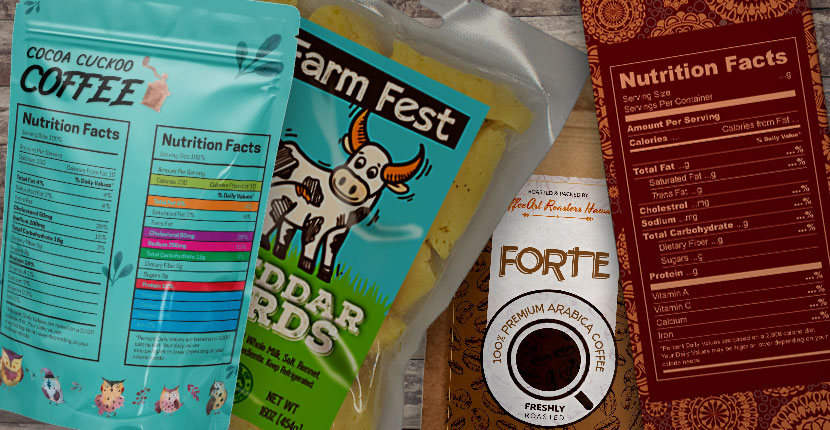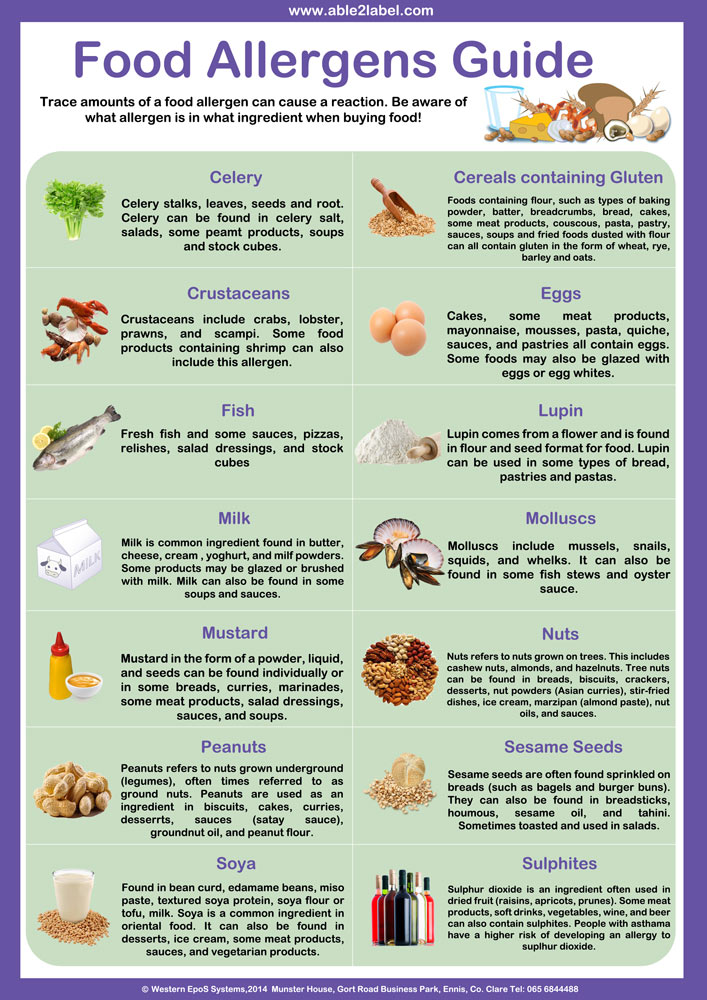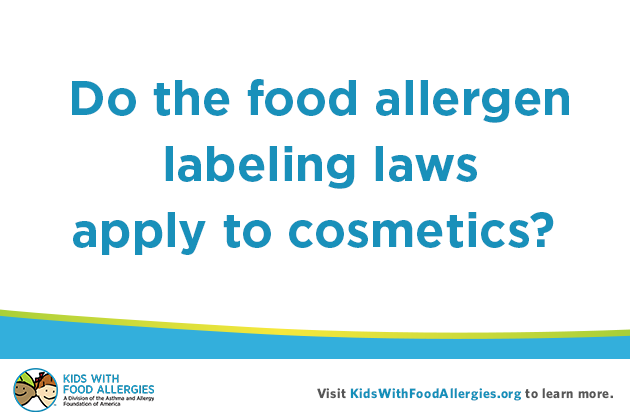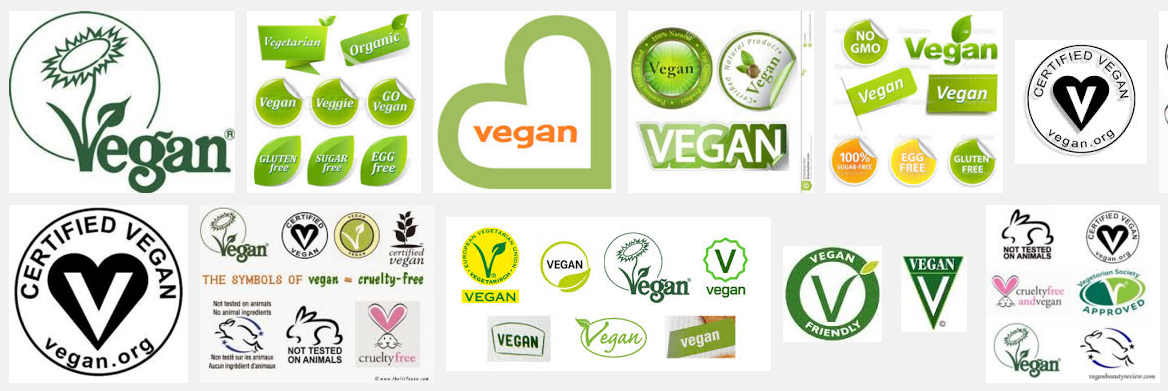38 allergens required on food labels
Allergens- Voluntary Labeling Statements | Food Safety and Inspection ... Issue Date June 2013. This guidance document assists firms formulate voluntary labeling statements regarding the possible presence of allergens in products. Label review for meat, poultry, and egg products is required by statute at 21 USC 607 (d), 456 (c), and 1036 (b), respectively. Under the Federal Meat Inspection Act (FMIA), the Poultry ... How to Read a Food Label - FoodAllergy.org Starting Jan. 1, 2023, allergen labeling of sesame will be required under the Food Allergy Safety, Treatment, Education and Research (FASTER) Act of 2021. Ingredients and manufacturing processes can change without warning. Make a habit of carefully reading labels to ensure you avoid any potential allergens. "May Contain" Statements
Allergen labelling for food manufacturers | Food Standards Agency 14 allergens If your product contains any of the main 14 allergens as an ingredient or processing aid, it must be included on the label. The 14 main allergens are: celery cereals containing gluten...

Allergens required on food labels
Allergens: Where Food Safety and Labeling Intersect In passing FALCPA, Congress noted that eight major foods or food groups—milk, eggs, fish, crustacean shellfish, tree nuts, peanuts, wheat, and soybeans—account for 90 percent of food allergies. These findings also cited a 1999 FDA review of randomly selected baked goods, ice cream, and candy showing that 25 percent of the sampled foods ... FDA: Food Labels Must List Allergens - WebMD Fish. Crustacean shellfish (like shrimp) Tree nuts. Peanuts. Wheat. Soybeans. The labeling will list these ingredients or say "contains" followed by the name of the source of the food allergen ... PDF Allergen Labeling on Food Products - University of Minnesota Allergen declaration is required on products regulated by the Food and Drug Administration (FDA), U.S. Department of Agriculture (USDA), and state regulatory authorities (e.g., Mississippi Department of Agriculture and Commerce, Mississippi State Department of Health, Mississippi Department of Marine Resources).
Allergens required on food labels. Hidden Food Allergens: Are Food Labels Reliable? - WebMD The Rising Threat of Hidden Food Allergens. July 23, 2015 -- For Donna Pierre, there's no more important job than reading food labels. Her 7-year-old daughter has a life-threatening peanut ... Everything You Need to Know About Food Allergen Labeling In 2022 According to the Food Allergen Labeling and Consumer Protection Act of 2004 (FALCPA), the term major allergens refers to the eight foods and their protein derivatives that cause more than 90% of food allergiesand severe reactions in the USA. So, any packaged food containing the following allergensmust declare the ingredients on its label to warn it... PDF FSIS Compliance Guidelines - Food Safety and Inspection Service Establishments are required to declare ingredients on the label if they are included in the product formulation (9 CFR 317.2 and 381.118). Allergen-containing products must be handled, ... 2004 Food Allergen Labeling and Consumer Protection Act (FALCP A) requires that products under the jurisdiction of the Food and Drug Administration (FDA ... Food Allergen Labeling: Helpful Hints To Manage "May Contain" Labeling ... Know the less common names for relevant food allergens. The eight most common food allergens are required to be listed as their common name, but less common allergens are not held to this same level of scrutiny. According to the FDA, " FALCPA identifies eight foods or food groups as the major food allergens. They are milk, eggs, fish (e.g ...
Food Allergies | FDA Jun 23, 2022 · To protect those with food allergies and other food hypersensitivities, the FDA enforces regulations requiring companies to list ingredients on packaged foods and beverages. For certain foods or... Allergen Labeling on Food Products - Mississippi State University Allergen declaration is required on products regulated by the Food and Drug Administration (FDA), U.S. Department of Agriculture (USDA), and state regulatory authorities (e.g., Mississippi Department of Agriculture and Commerce, Mississippi State Department of Health, Mississippi Department of Marine Resources). Label Reading for Food Allergens | Gordon Food Service All foods regulated by the Food and Drug Administration (FDA) that contain a major food allergen are required by law to list the allergen on the product label. Major food allergens = milk, wheat, egg, peanuts, tree nuts, fish, crustacean shellfish, and soy. Food Allergen Labeling and Consumer Protection Act. The law that dictates this is the ... Allergen Labeling Requirements — FDA Reader Dec 07, 2020 · What You Need to Know: Most but not all foods sold in the US require an allergen statement. In order to create an allergen label for your product you must understand the ingredients and their origins. Allergen statements typically follow a standard wording that you can use. Don’t overthink
FALCPA identifies eight foods or food groups as the major food allergens. They are milk, eggs, fish (e.g., bass, flounder, cod), Crustacean shellfish (e.g., crab, lobster, shrimp), tree nuts (e.g.,... PDF Food Allergen Labelling and Information Requirements FSA Food Allergen Labelling and Information Requirements: Technical Guidance - June 2020 . 9 . on food businesses to label PPDS food with a list of ingredients containing emphasised allergens bringing the provision of allergen information in line with labelling for prepacked food, reducing consumer confusion. 18. Food Allergen Labeling Law Requirements and Exceptions Tree nuts (e.g., pecans and almonds) Peanuts Wheat, and Soybeans According to the FDA, these are the allergens that cause the most problems in the U.S. Foods that contain these allergens need to list them in the ingredients label on the package. In addition, manufacturers must use use the "common or usual name" of the allergen. Must allergens be declared on labels? - USDA Must allergens be declared on labels? Jul 17, 2019 Knowledge Article Yes. All food products containing two or more ingredients are required by federal regulations to bear an ingredients statement listing all ingredients by common or usual name in descending order of predominance.
Food Allergen Labelling | Laws. Types Of Labels, Effectiveness There are 14 food allergens that you need to be aware of and these ingredients must be clearly marked and declared on any food offered for sale. Nuts (almonds, hazelnuts, walnuts, pecan nuts, sesame, Brazil nuts, pistachio, cashew, Macadamia or Queensland nut). Peanuts. Eggs including egg derived substances such as albumen. Milk and dairy.
Understanding the FDA Food Allergen Labeling Requirements Are We Required to List Allergens on Our Food Labels? Yes, manufacturers need to declare the presence of allergens in their product if it has any. It is required by law under the Food Allergen Labeling and Consumer Protection Act, which is simply known as "FALCPA." Food allergies occur when some types of food trigger an immune reaction.
Another nut added to Japan's allergen labelling list Japan's Consumer Affairs Agency (CAA) has announced it will add walnuts to the list of allergens that food manufacturers and importers must include on product packaging labels. Now, the only allergens required to be labelled when present in a food are egg, milk, wheat, crab, shrimp, buckwheat (soba) and peanut. Labelling the presence of walnuts…
TTBGov - Major Food Allergen Labeling TTB has published an interim rule, effective July 26, 2006, allowing the voluntary labeling of major food allergens on the labels of wines, distilled spirits, and malt beverages. The regulatory provisions allowing the voluntary labeling of major food allergens are contained in T.D. TTB-53, published in the Federal Register on July 26, 2006.
Food Labeling - FoodAllergy.org Food labels need to be accurate and truthful to help people with food allergies stay safe. Issues can arise when companies change the way they manufacture a food—or when they occasionally make mistakes. As of 2016, the U.S. Food and Drug Administration (FDA) has the authority to initiate allergen-related recalls.
Allergen Labeling - TTBGov consistent with the provisions of the food allergen labeling and consumer protection act of 2004, falcpa, the interim rule defines a "major food allergen" to mean any of the following: milk, egg, fish (for example, bass, flounder, or cod), crustacean shellfish (for example, crab, lobster, or shrimp), tree nuts (for example, almonds, pecans, or …
Food Labels: Read It Before You Eat It! - AAAAI Ingredients of these most common eight allergens must be labeled with clearly recognized English names of the food source as listed above. The "contains" statement is "voluntary", but if used, must include ALL of the allergenic ingredients from the list of eight allergenic sources as described in item 14 of the 2006 guidance document.

How to manage food labels to ensure allergens are clearly noted on any product | 2020-07-29 ...
Food Allergy & Anaphylaxis | Food Labeling | Food Labels Only crustacean shellfish (e.g. crabs, shrimp, lobster, or crayfish) and not mollusks (eg. clams, mussels, scallops, or squid) are required to be labeled on packaged goods. The labeling law applies only to foods regulated by the FDA.
How to Read a Food Label — SPOKIN Step 1: Understand how and where to find allergen information on a label. If your allergen is a Top 8: The Food Allergen Labeling, Consumer Protection Act, requires by law, that packaged foods list an allergen in plain english if it is an ingredient. This only is required if the allergen is one of the top 8 which include peanut, tree nut, milk ...
Allergen labelling - Food Standards In February 2021, new plain English allergen labelling requirements were introduced for how certain foods known to be common allergens are declared. These changes will mean food allergen information is clearer and easier to find on food labels. Food businesses have three years to update their labels to meet the new requirements.
Allergen declarations, warnings, and advisory statements on food labels ... The allergens that must be declared are: peanuts almonds Brazil nuts cashews hazelnuts macadamias pecans pine nuts pistachios walnuts crustacea molluscs fish milk egg gluten (that is found in wheat, rye, barley, oats, spelt, and triticale) wheat soy sesame lupin sulphites (must be listed if added at 10 (or more) milligrams per kilogram of food)
PDF Allergen Labeling on Food Products - University of Minnesota Allergen declaration is required on products regulated by the Food and Drug Administration (FDA), U.S. Department of Agriculture (USDA), and state regulatory authorities (e.g., Mississippi Department of Agriculture and Commerce, Mississippi State Department of Health, Mississippi Department of Marine Resources).
FDA: Food Labels Must List Allergens - WebMD Fish. Crustacean shellfish (like shrimp) Tree nuts. Peanuts. Wheat. Soybeans. The labeling will list these ingredients or say "contains" followed by the name of the source of the food allergen ...
Allergens: Where Food Safety and Labeling Intersect In passing FALCPA, Congress noted that eight major foods or food groups—milk, eggs, fish, crustacean shellfish, tree nuts, peanuts, wheat, and soybeans—account for 90 percent of food allergies. These findings also cited a 1999 FDA review of randomly selected baked goods, ice cream, and candy showing that 25 percent of the sampled foods ...












Post a Comment for "38 allergens required on food labels"